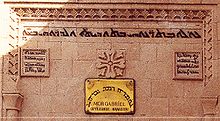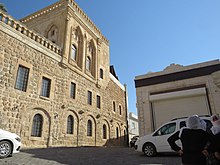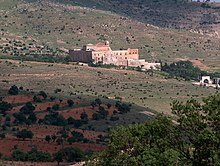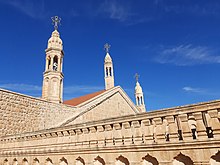Tur Abdin

| Part of Oriental Orthodoxy |
 |
| Oriental Orthodox churches |
|---|
|
|
Tur Abdin (
The name "Tur Abdin" is
Geography
Settlements
The town of
History
Antiquity


The Assyrian king Adad-nirari II, who came to throne in the late 10th century BCE, removed the Arameans from political power in the Kashiari mountains (Tur Abdin).[8] In the 9th century BCE the Assyrian King Ashurnasirpal II described crossing the plateau of Tur Abdin (which he calls "Kashyari") on his way to attack the region of Nairi, more than once.[9][10] He erected a monument in Matiate, modern-day Midyat in Tur Abdin, which remains to be found.[11] His successor, the Assyrian king Shalmaneser III, also crossed Tur Abdin.[12]
Most ancient monuments in Tur Abdin are
In 586 B.C. the prophet Ezekiel mentions the famed wine of Izlo, on the southern edge of the plateau of Tur Abdin, in his prophecy against Tyre.[citation needed]
The Mor Gabriel Monastery, the oldest Syriac Orthodox church in the world, was founded in 397 by the ascetic Mor Shmu'el (Samuel) and his student Mor Shem'un (Simon). According to tradition, Shem'un had a dream in which an Angel commanded him to build a House of Prayer in a location marked with three large stone blocks. When Shem'un awoke, he took his teacher to the place and found the stone the angel had placed. At this spot Mor Gabriel Monastery was built.[16][citation needed]
In
The fortress of Rhabdion was mentioned by the 6th-century Greek historian Procopius, while the 6th-century Notitia Antiochena and the work of the 7th-century Greek geographer George of Cyprus both attest that Turabdium was an episcopal see.[3] The bishop of Turabdium's seat was probably the village of Hah, in which were, besides the functioning 6th-century monastery, several ruined churches including the cathedral.[3] The Tur Abdin became part of the Rashidun Caliphate in 640, during the Muslim conquest of the Levant.[3] The Syriac Orthodox communities flourished under early Islamic rule; nearly 30 structures are known to have been wholly built or rebuilt in the following 150 years, during which most of the villages' churches were built.[3]
After the Council of Chalcedon in 451 AD, the Syriac Orthodox Church split from the Greek-speaking Byzantine mainstream. They were then "severely persecuted as heretical
Modern
Gaunt has estimated the Assyrian population at between 500,000 and 600,000 just before the outbreak of World War I, significantly higher than reported on Ottoman census figures.

During
Due to migration, the Syriacs' main residential area in Turkey today is Istanbul, where between 12,000 to 18,000 lives there.[25] As of 2019, an estimated between 2,000 to 3,000 of the country's 25,000 Assyrians live in Tur Abdin,[25] and they are spread among 30 villages, hamlets, and towns.[25] Some of these locations are dominated by Syriacs while others are dominated by the Kurds.[25] As part of a return movement, some Syriac Orthodox Christians returned to Tur Abdin villages from Germany, Sweden and Switzerland.[26][27][25]
Christian resistance in Tur Abdin during WW1
The Syriacs of
We all have to die sometime, do not die in shame and humiliation
Recent conflicts
On 10 February 2006 and the following day, large demonstrations took place in the city of
In 2008 a series of legal challenges were made against the monastery of Mor Gabriel. Some local Kurdish villages sought to claim land on which the monastery had paid taxes since the 1930s as belonging to the villages, and made other accusations against the monastery. This led to considerable diplomatic and human rights action throughout Europe and within Turkey.[30]
Monasteries



The most important Syriac Orthodox centre in Tur Abdin is the monastery of
In the centre of the Tur Abdin region, a few miles south of
The Saffron and Mor Gabriel monasteries are the most important of the region, existing along with six or seven other active monasteries:
- The Mt. Izla, has only been recently revived. It has a historical significance to the region. As evidence of that, a Syriac Orthodox Bishop in the Netherlands took the name Auginin respect for the founder of the monastery.
- The Mor Abroham Monastery is located less than a mile east of Midyat, and it is known for having a large amount of farmland, some of which they donated to house Syrian refugees. Directly adjacent to the monastery lies the Turabdin Hotel and winery, which uses the monasteries vineyards to produce unique Syriac wines endemic to the region.
- The St. Meryemana (Mary) Monastery, located next to the village of Anıtlı, functions as the religious center for the remaining Christians of the village, and has a school for Syriac children.
- The Mor Yakup (Jacob) Monastery is located next to the village of Baristepe, and, like the St Mary Monastery, functions as the religious center for the remaining Christians of the village.
- A second Mor Yakup Monastery is located in the village of Dibek (Syriac Badibe), having been rebuilt and occupied in 2013.[32]
- The Mor Malke Monastery is located on the northern slope of Mount Izla and is a few miles south of the village of Üçköy; it is connected by road to the village. Mor Malke is one of the newer monasteries of the region in terms of architecture, as it was rebuilt in the 30s. The monastery has a school, a church, and some farmlands.[33]
- One Monastery known as Mor Aho Monastery was abandoned during the 1900s, but was later turned into a small walled village, when two dozen or so Syriac villagers built houses in the courtyard of the Monastery because its high walls allowed for better security and defense than what their nearby village provided. The Monastery has one Nun, but as it has no monks or consistent liturgy held in its church it is technically not a monastery.[34]
Notable people
- Ibrahim Baylan (b. 1972), Swedish politician of Assyrian/Syriac descent
- Shamoun Hanna Haydo (1870-1964), Assyrian/Syriac leader in the early 20th century
- Nuri Kino, Swedish-Assyrian/Syriac descent journalist
See also
- Assyrians in Turkey
- Hakkari, another historical Syriac Christian region in Turkey
- Patriarchate of Tur Abdin
- Turoyo language
References
- ^ Aras, Ramazan (2020). The Wall: The Making and Unmaking of the Turkish-Syrian Border. Springer Nature. p. 16.
- ^ Thomas A. Carlson et al., “Ṭur ʿAbdin — ܛܘܪܥܒܕܝܢ ” in The Syriac Gazetteer last modified December 9, 2016, http://syriaca.org/place/221.
- ^ ISBN 978-0-19-866277-8, retrieved 2020-11-28
- ISBN 9781444320022.
- ISBN 978-1-59333-715-5.
- ^ The Middle East, abstracts and index, Part 1. Library Information and Research Service. Northumberland Press, 2002. Page 491.
- ^ Central Asia and the Caucasus: transnationalism and diaspora. Touraj Atabaki, Sanjyot Mehendale. Routledge, 2005. Page 228.
- ISBN 9780140125238.
- ^ From Kibaki I set out and approached Matiate (Midyat). Matiate and its villages I overcame . . . For six days in the midst of the mighty mountain of Kashyari (Tur Abdin) - a difficult country . . . I worked that mountain with iron axes . . . Then I caused my chariots . . . to pass over it . . . I passed mount Kashyari and came a second time to the lands of Nairi.
- ^ Radner (2006), pp. 287–299.
- ^ Radner (2006), pp. 299.
- ^ Radner (2006), pp. 288.
- ^ Palmer (1990), pp. 28–29.
- ^ Palmer (1990), pp. 29–30.
- ^ Parpola 2004, p. 21.
- ^ "turabdin.info". ww38.turabdin.info. Archived from the original on Apr 19, 2015. Retrieved Jan 30, 2023.
- ISBN 978-0-19-504652-6, retrieved 2020-12-15
- )
- ^ a b Gaunt 2015, p. 87.
- ^ Üngör 2011, p. 13.
- ^ Üngör 2011, p. 15.
- ^ Gaunt et al. 2017, p. 19.
- ^ Gaunt 2020, p. 57.
- ^ "Assyrians who fled to Europe return to homes in Turkey's Mardin". Daily Sabah. 13 July 2017.
- ^ ISBN 9781137270269.
- ^ Çaglar (2013), p. 122
- ^ Güsten (2016), p. 11
- ISBN 9780674916456.
- ISBN 978-1-59333-301-0.
- ^ "The Case of the St. Gabriel Assyrian Monastery in Midyat, Turkey". www.aina.org. Retrieved Jan 30, 2023.
- ^ Delcogliano, Mark. "Syriac Monasticism in Tur Abdin: A Present-Day Account". Academia.edu.
- ^ "Kirche unterwegs – Reiseblogs aus der Evangelischen Kirche von Westfalen".
- ^ "Tur Abdin". Archived from the original on 2016-08-05. Retrieved 2016-06-12.
- ^ "Aina website". Archived from the original on 2016-04-22. Retrieved 2016-08-24.
Sources
- ISBN 9781593337155.
- Bilgic, Zeki (2018). "Aramäisch des Tur Abdin schreiben und lesen: Überlegungen, warum die Sprechergemeinschaft des Tur Abdin das Neu-Aramäische nicht als Schriftsprache anerkennt". Neue Aramäische Studien: Geschichte und Gegenwart. Frankfurt am Main: Peter Lang. pp. 215–250. ISBN 9783631731314.
- Birol, Simon (2018). "Forgotten Witnesses: Remembering and Interpreting the Sayfo in the Manuscripts of Tur 'Abdin". Sayfo 1915: An Anthology of Essays on the Genocide of Assyrians/Arameans during the First World War. Piscataway, NJ: Gorgias Press. pp. 327–346. ISBN 9781463207304.
- Borbone, Pier Giorgio (2017). "From Tur 'Abdin to Rome: The Syro-Orthodox Presence in Sixteenth-Century Rome". Syriac in its Multi-Cultural Context. Leuven: Peeters Publishers. pp. 277–287. ISBN 9789042931640.
- Comfort, Anthony (2017). "Fortresses of the Tur Abdin and the Confrontation between Rome and Persia". Anatolian Studies. 67: 181–229. S2CID 164455185.
- Jastrow, Otto (1993) [1967]. Laut- und Formenlehre des neuaramäischen Dialekts von Mīdin im Ṭūr ʻAbdīn. Wiesbaden: Harrassowitz Verlag. ISBN 9783447027441.
- Gaunt, David (2015). "The Complexity of the Assyrian Genocide". Genocide Studies International. 9 (1): 83–103. ISSN 2291-1847.
- ISBN 978-0-19-965522-9.
- Gaunt, David; Atto, Naures; Barthoma, Soner O. (2017). "Introduction: Contextualizing the Sayfo in the First World War". Let Them Not Return: Sayfo - The Genocide Against the Assyrian, Syriac, and Chaldean Christians in the Ottoman Empire. Berghahn Books. pp. 1–32. ISBN 978-1-78533-499-3.
- Gaunt, David (2020). "The Long Assyrian Genocide". Collective and State Violence in Turkey: The Construction of a National Identity from Empire to Nation-State. Berghahn Books. pp. 56–96. ISBN 978-1-78920-451-3.
- Keser-Kayaalp, Elif (2019). "Church Building in the Ṭur 'Abdin in the First Centuries of the Islamic Rule". Authority and Control in the Countryside: From Antiquity to Islam in the Mediterranean and Near East (Sixt-Tenth Century). Leiden-Boston: Brill. pp. 176–209. ISBN 9789004386549.
- Palmer, Andrew (1990). Monk and Mason on the Tigris Frontier: The Early History of Ṭur 'Abdin. Cambridge: Cambridge University Press. ISBN 9780521360265.
- Parpola, Simo (2004). "National and Ethnic Identity in the Neo-Assyrian Empire and Assyrian Identity in Post-Empire Times". Journal of Assyrian Academic Studies. 18 (2): 5–22.
- Prym, Eugen; Socin, Albert (1881). Der neu-aramaeische Dialekt des Ṭûr 'Abdîn. Göttingen: Vandenhoeck & Ruprecht's Verlag.
- Radner, Karen (2006). "How to reach the Upper Tigris: The route through the Tur Abdin". State Archives of Assyria Bulletin. 15: 273–305.
- Saadi, Abdul-Massih (2018). "Interdependence of Classical Syriac and Suryoyo of Tur Abdin (STA): Orthography for the STA". Neue Aramäische Studien: Geschichte und Gegenwart. Frankfurt am Main: Peter Lang. pp. 169–192. ISBN 9783631731314.
- ISBN 9783643902689.
- Saouk, Joseph (2015). "Quo vadis Turoyo? A Description of the Situation and the Needs of the Neo-Aramaic of Tur-Abdin (Turkey)". Parole de l'Orient. 40: 361–377.
External links
![]() Media related to Tur Abdin at Wikimedia Commons
Media related to Tur Abdin at Wikimedia Commons
